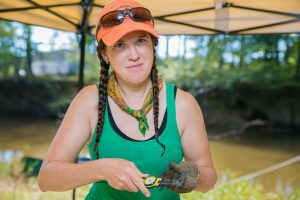
Freshwater mussels once carpeted the bottom of rivers and creeks throughout the Southeast, cleaning the water by filtering it through their gills while eating.
Alabama is a hotbed for freshwater mussels, with 180 species – about two-thirds of North American species – calling the state’s waterways home.
However, more than half of those are threatened. Across the country, more than 70 percent of freshwater mussels are imperiled as human development has harmed river ecosystems.
“They’ve become more and more rare over time, and some of these species are never coming back,” said Dr. Carla Atkinson, an ecologist at The University of Alabama. “If we want to make sure our rivers are functioning the way they have historically, we need to step in and do something about it.”
Atkinson is integral to research at UA to help better understand freshwater mussels, improving efforts to conserve and restore the animal to the state’s streams and rivers.
“In order to do recovery, we have to understand the general biology of these organisms,” Atkinson said. “If we’re not putting conservation dollars in the right place, so these animals can actually persist and survive and eventually reproduce, it’s just money down the toilet.”
Not only do mussels maintain and improve water quality through filter feeding, but they change their physical habitat and, in turn, the river’s characteristics such as shape and depth.
Atkinson led a preliminary study that found mussels dislodge smaller sediment particles into the river’s flow and sink larger pieces deeper as they burrow into the riverbed.
The impact could be significant considering mussels live in pockets of huge numbers with some living more than 100 years. It’s a novel idea, and it should be considered when restoring rivers, said Dr. Lisa Davis, a fluvial geomorphologist at UA who studies river erosion and deposition and worked with Atkinson on the project.
“Mussels are an important part of certain rivers in terms of establishing their ecosystem function as well as some of their physical process,” said Davis. “If you look at how rivers are restored today, they don’t always incorporate organisms that might be engineering the environment.”
A lot of the work Atkinson does with mussels is done in the Sipsey River, a meandering, 92-mile river in West Alabama. As one of the last free-flowing rivers in Alabama, it is home to 37 mussel species.
The projects from UA researchers will help state conservationists better manage restoration efforts.
“There’s still time,” Atkinson said. “We can do something to try to understand their biology and do something to better protect these areas where biodiversity has hung on.”
Learn more about the research by reading the full article on the UA news site.